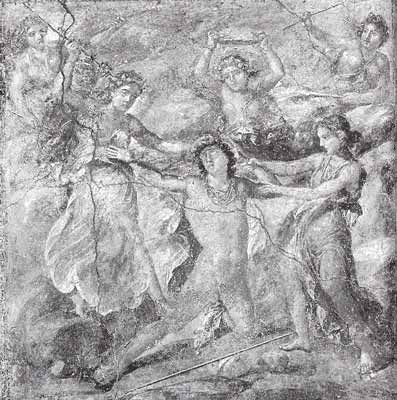In the screening on Friday we watched Jean Cocteau’s The Blood of the Poet (Le Sang d'un Poete). It’s probably the earliest ‘experimental’ film I have seen (it was made around 1933) and it was pretty mesmerising.
It was full of vivid imagery, referencing Greek mythology, and even Christian symbols. I've had an interest in Greek mythology probably since learning about it in year 5 or 6. I can't precisely pin down what attracts me to these myths, but I would say it would be perhaps a combination of the exoticism in the polytheistic nature of their stories, the vivid imagery the stories conjure, and, of course, the blood-letting and revenge (while it is a Roman-ised version, who can go past the story of the Bacchae?).

Pentheus being torn into by the women of Bacchus.
So from this background, the references to Hermaphrodite (in Episode Two, through the key-hole) and Europa (in the closing stages of Episode Four) gave me a familiar reference in an oneiric cinescape.

Europa and Zeus as a bull.
Also, I picked up on some Christian images, however perhaps I just read a little too much into it (i think 13 years of Catholic schooling may be taking its toll...). Moments such as the painter/poet/protagonist first seeinging the mouth on his hand in Episode One, to me, referenced the stigmata of the hands, while the scene of the mask with two faces (one concave and one convex), also in Episode Two, referenced tears of blood. In Episode Two, in the first door the poet looks through, an execution takes place. Behind the victim we can see a small statue of Mary and Jesus, which is also shot. Perhaps Cocteau was proposing a refection on many types of spirituality or relgious expression; what do you think?
I was also intrigued by many of the techniques Cocteau used – the change of place between Episode One and Episode Two, the change of time between Episodes One and Two and Episode Three. Cocteau’s use of analogue techniques was interesting to watch as someone who has grown up in the digital age – something that I also found watching Rose Hobart – did anyone feel the same way? I think growing up alongside computers has made us take techniques, such as computer generated effects, for granted.
Watching Cocteau’s characters fly around ‘on the ceiling’, like the little girl behind the “Flying Lessons” door, or the poet/protagonist falling through the mirror, it was fairly obvious that the director used what he could to make the imaginable possible. It seemed as though the actors were performing lying on the floor, while the camera was positioned above them, in order to pretend the actors were defying gravity, or falling through mirrors (which was a small pool on the ground).
In comparison with Cornell's Rose Hobart, which we watched in the first seminar, I liked the confronting nature The Blood of the Poet exhibited... but this is coming from a girl who will take Nick Cave and Beckett over more moderate forms of literature or entertainment anyday...
After discussing Rose Hobart in the second seminar, I did feel more of an appreciation for artistic particularity Cornell instilled in the film: through using techniques more commonly used in the Silent Era, such as a blue filter for nighttime scenes, and a slower rate of frames per second - both of which I found gave the film an ethereal kind of quality.
Viewing both of these films has reminded me that movie techniques existed long before the computer (of course I remember the days of the hand drawn cartoons and the low-fi Wiggles) but I think this generation has become a little too dependent on high-tech computer generated graphics, when really we should just try performing on the floor a little bit more often.

No comments:
Post a Comment